Monitor and Evaluate Nursing Care Plans for Patient with Traumatic Brain Injury
VerifiedAdded on 2023/04/25
|9
|978
|125
AI Summary
This document provides nursing care plans for a patient with traumatic brain injury. It includes health metrics, goals, interventions, and rationale for each concern. The document also covers the review concerns and references for further reading.
Contribute Materials
Your contribution can guide someone’s learning journey. Share your
documents today.
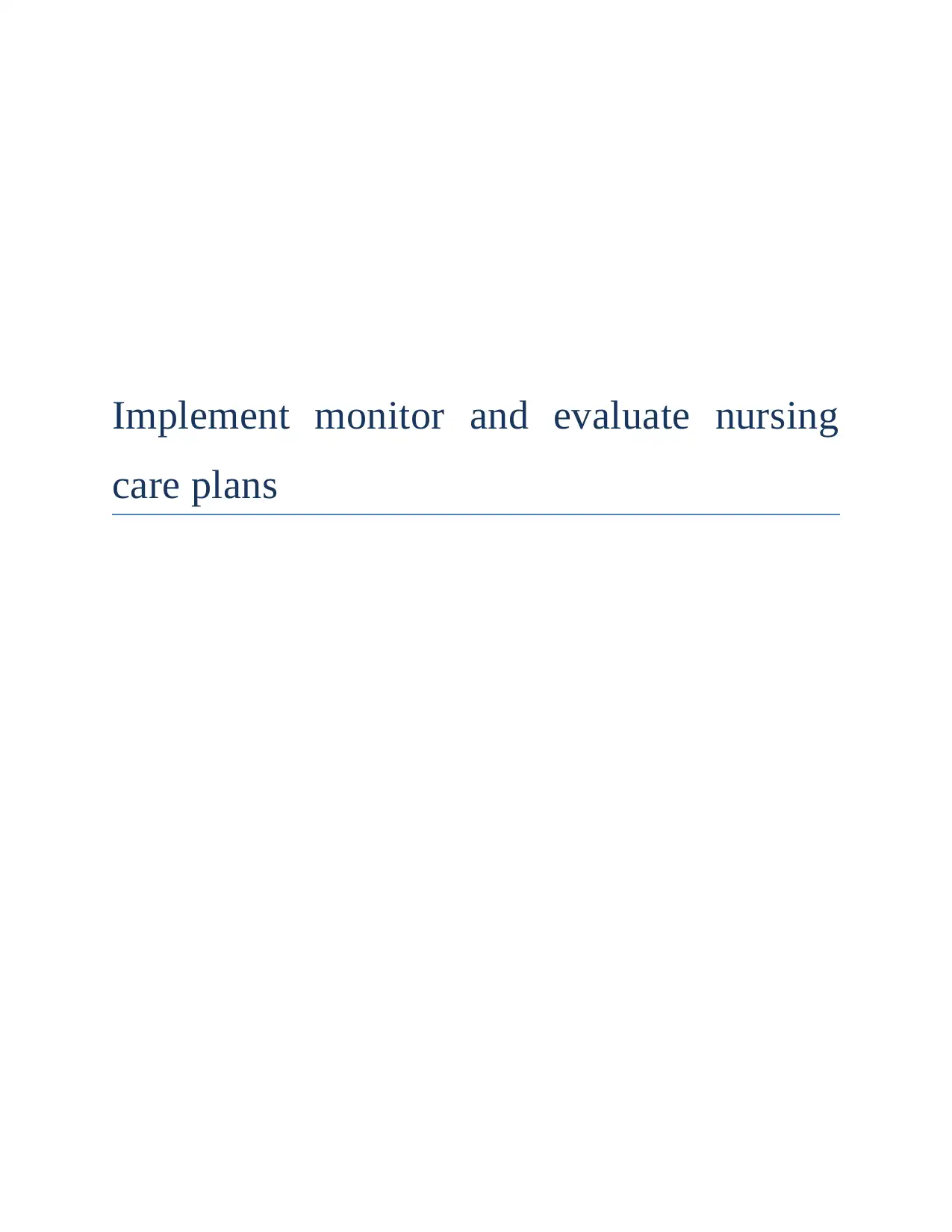
Implement monitor and evaluate nursing
care plans
care plans
Secure Best Marks with AI Grader
Need help grading? Try our AI Grader for instant feedback on your assignments.
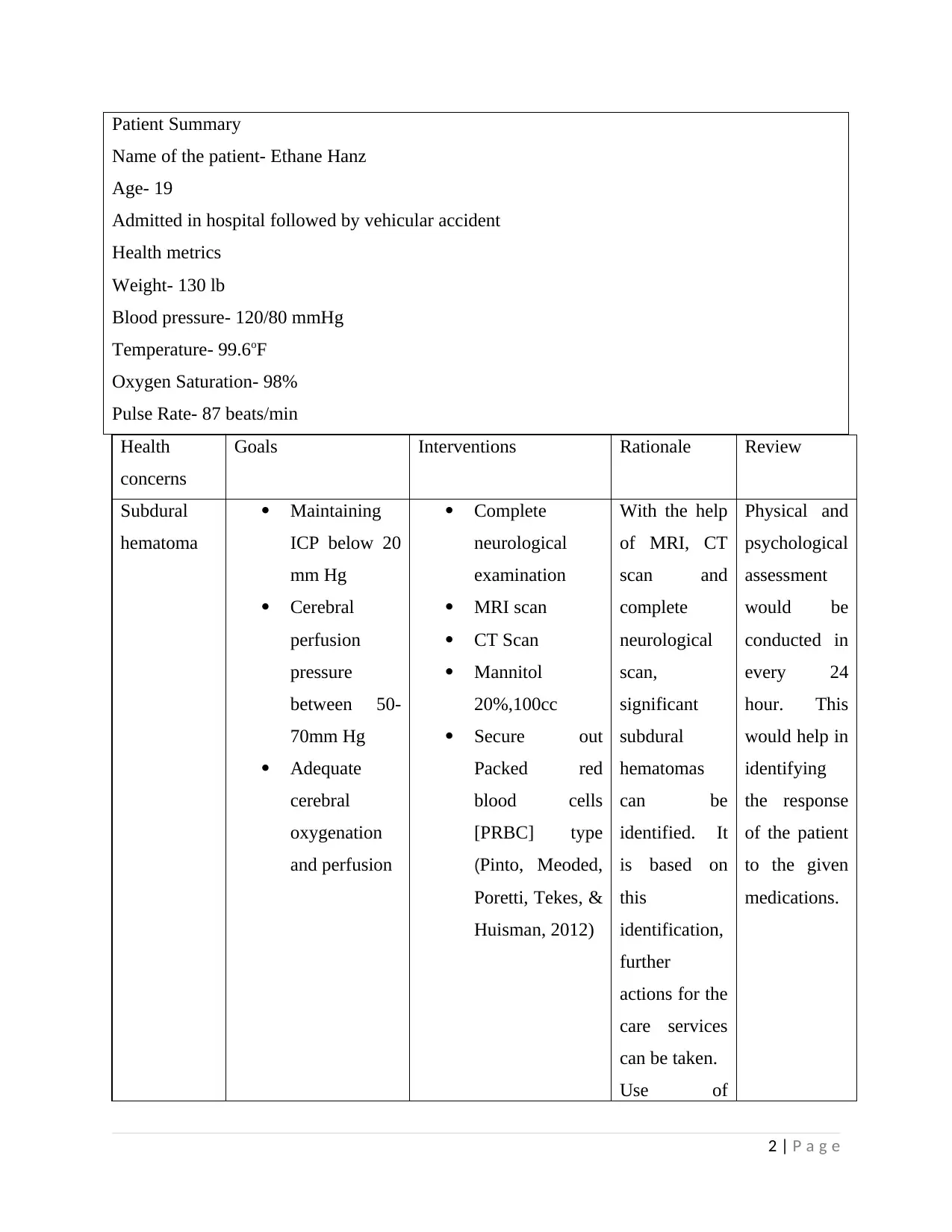
Patient Summary
Name of the patient- Ethane Hanz
Age- 19
Admitted in hospital followed by vehicular accident
Health metrics
Weight- 130 lb
Blood pressure- 120/80 mmHg
Temperature- 99.6oF
Oxygen Saturation- 98%
Pulse Rate- 87 beats/min
Health
concerns
Goals Interventions Rationale Review
Subdural
hematoma
Maintaining
ICP below 20
mm Hg
Cerebral
perfusion
pressure
between 50-
70mm Hg
Adequate
cerebral
oxygenation
and perfusion
Complete
neurological
examination
MRI scan
CT Scan
Mannitol
20%,100cc
Secure out
Packed red
blood cells
[PRBC] type
(Pinto, Meoded,
Poretti, Tekes, &
Huisman, 2012)
With the help
of MRI, CT
scan and
complete
neurological
scan,
significant
subdural
hematomas
can be
identified. It
is based on
this
identification,
further
actions for the
care services
can be taken.
Use of
Physical and
psychological
assessment
would be
conducted in
every 24
hour. This
would help in
identifying
the response
of the patient
to the given
medications.
2 | P a g e
Name of the patient- Ethane Hanz
Age- 19
Admitted in hospital followed by vehicular accident
Health metrics
Weight- 130 lb
Blood pressure- 120/80 mmHg
Temperature- 99.6oF
Oxygen Saturation- 98%
Pulse Rate- 87 beats/min
Health
concerns
Goals Interventions Rationale Review
Subdural
hematoma
Maintaining
ICP below 20
mm Hg
Cerebral
perfusion
pressure
between 50-
70mm Hg
Adequate
cerebral
oxygenation
and perfusion
Complete
neurological
examination
MRI scan
CT Scan
Mannitol
20%,100cc
Secure out
Packed red
blood cells
[PRBC] type
(Pinto, Meoded,
Poretti, Tekes, &
Huisman, 2012)
With the help
of MRI, CT
scan and
complete
neurological
scan,
significant
subdural
hematomas
can be
identified. It
is based on
this
identification,
further
actions for the
care services
can be taken.
Use of
Physical and
psychological
assessment
would be
conducted in
every 24
hour. This
would help in
identifying
the response
of the patient
to the given
medications.
2 | P a g e
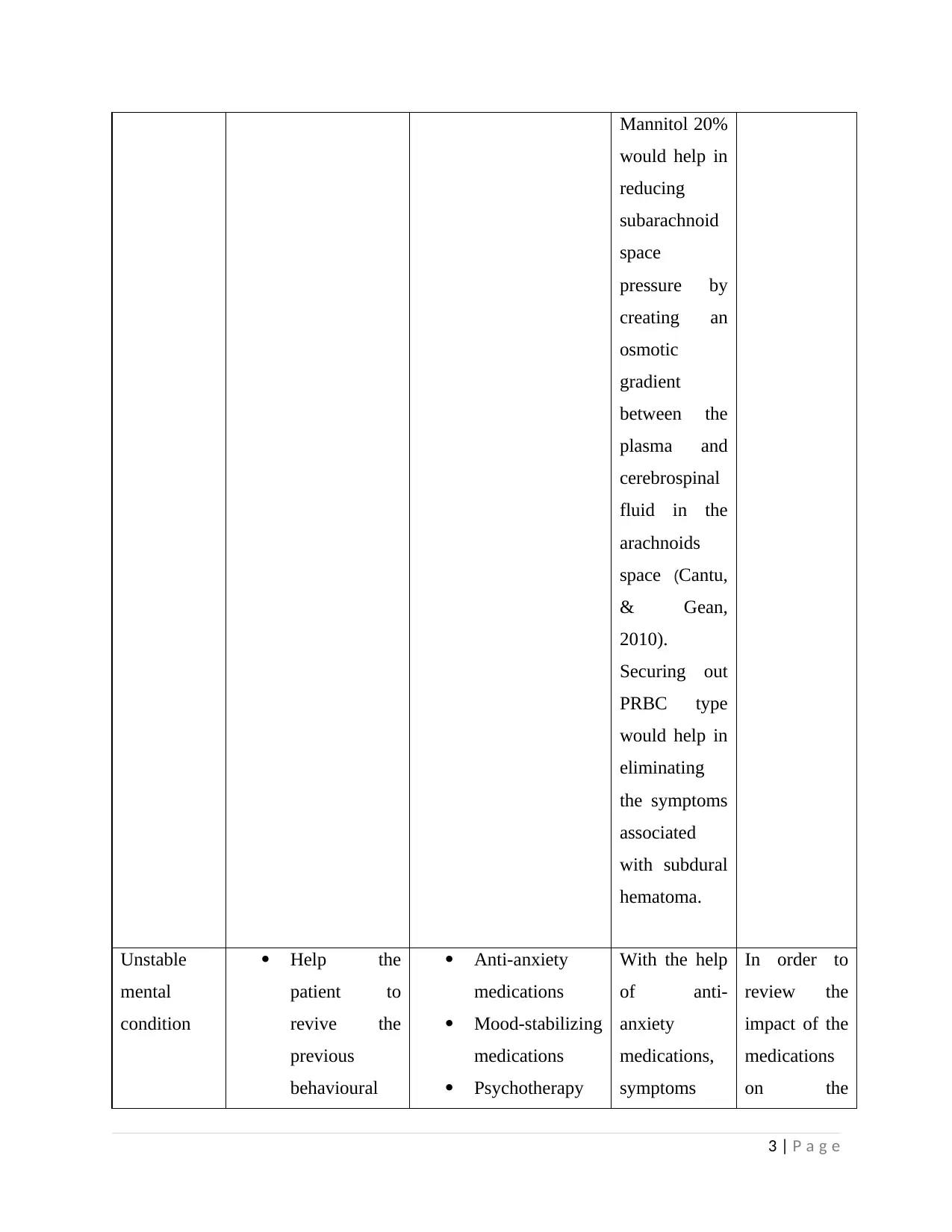
Mannitol 20%
would help in
reducing
subarachnoid
space
pressure by
creating an
osmotic
gradient
between the
plasma and
cerebrospinal
fluid in the
arachnoids
space (Cantu,
& Gean,
2010).
Securing out
PRBC type
would help in
eliminating
the symptoms
associated
with subdural
hematoma.
Unstable
mental
condition
Help the
patient to
revive the
previous
behavioural
Anti-anxiety
medications
Mood-stabilizing
medications
Psychotherapy
With the help
of anti-
anxiety
medications,
symptoms
In order to
review the
impact of the
medications
on the
3 | P a g e
would help in
reducing
subarachnoid
space
pressure by
creating an
osmotic
gradient
between the
plasma and
cerebrospinal
fluid in the
arachnoids
space (Cantu,
& Gean,
2010).
Securing out
PRBC type
would help in
eliminating
the symptoms
associated
with subdural
hematoma.
Unstable
mental
condition
Help the
patient to
revive the
previous
behavioural
Anti-anxiety
medications
Mood-stabilizing
medications
Psychotherapy
With the help
of anti-
anxiety
medications,
symptoms
In order to
review the
impact of the
medications
on the
3 | P a g e
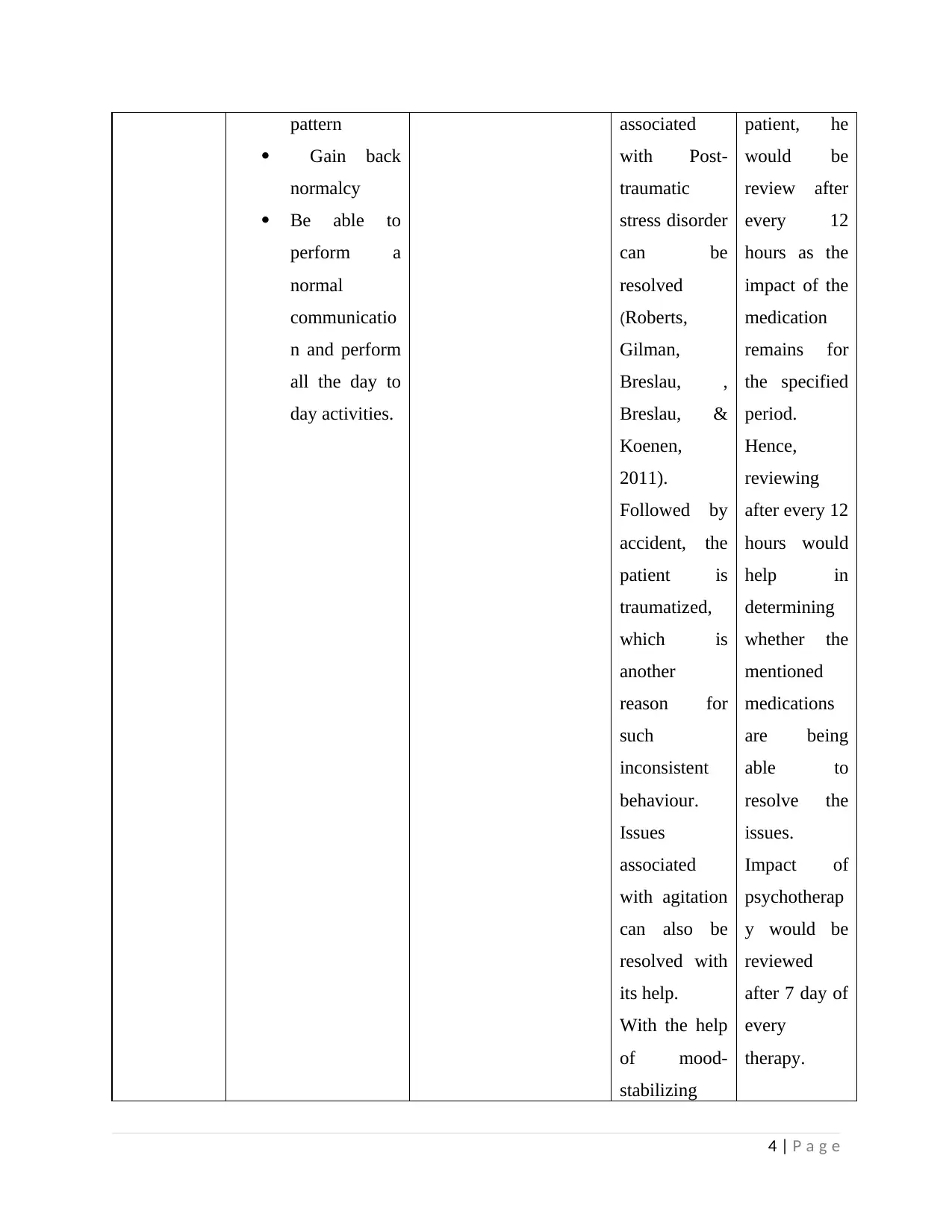
pattern
Gain back
normalcy
Be able to
perform a
normal
communicatio
n and perform
all the day to
day activities.
associated
with Post-
traumatic
stress disorder
can be
resolved
(Roberts,
Gilman,
Breslau, ,
Breslau, &
Koenen,
2011).
Followed by
accident, the
patient is
traumatized,
which is
another
reason for
such
inconsistent
behaviour.
Issues
associated
with agitation
can also be
resolved with
its help.
With the help
of mood-
stabilizing
patient, he
would be
review after
every 12
hours as the
impact of the
medication
remains for
the specified
period.
Hence,
reviewing
after every 12
hours would
help in
determining
whether the
mentioned
medications
are being
able to
resolve the
issues.
Impact of
psychotherap
y would be
reviewed
after 7 day of
every
therapy.
4 | P a g e
Gain back
normalcy
Be able to
perform a
normal
communicatio
n and perform
all the day to
day activities.
associated
with Post-
traumatic
stress disorder
can be
resolved
(Roberts,
Gilman,
Breslau, ,
Breslau, &
Koenen,
2011).
Followed by
accident, the
patient is
traumatized,
which is
another
reason for
such
inconsistent
behaviour.
Issues
associated
with agitation
can also be
resolved with
its help.
With the help
of mood-
stabilizing
patient, he
would be
review after
every 12
hours as the
impact of the
medication
remains for
the specified
period.
Hence,
reviewing
after every 12
hours would
help in
determining
whether the
mentioned
medications
are being
able to
resolve the
issues.
Impact of
psychotherap
y would be
reviewed
after 7 day of
every
therapy.
4 | P a g e
Secure Best Marks with AI Grader
Need help grading? Try our AI Grader for instant feedback on your assignments.
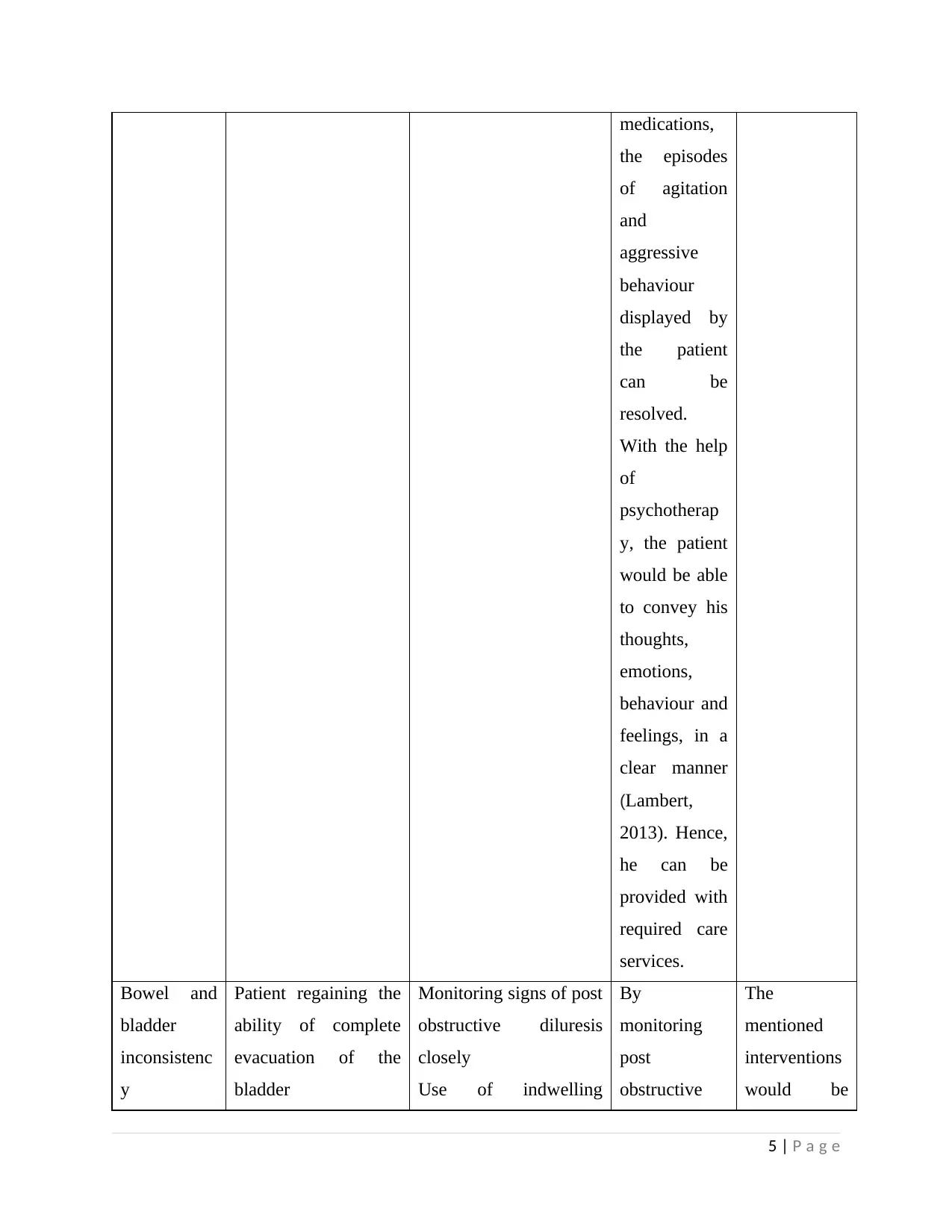
medications,
the episodes
of agitation
and
aggressive
behaviour
displayed by
the patient
can be
resolved.
With the help
of
psychotherap
y, the patient
would be able
to convey his
thoughts,
emotions,
behaviour and
feelings, in a
clear manner
(Lambert,
2013). Hence,
he can be
provided with
required care
services.
Bowel and
bladder
inconsistenc
y
Patient regaining the
ability of complete
evacuation of the
bladder
Monitoring signs of post
obstructive diluresis
closely
Use of indwelling
By
monitoring
post
obstructive
The
mentioned
interventions
would be
5 | P a g e
the episodes
of agitation
and
aggressive
behaviour
displayed by
the patient
can be
resolved.
With the help
of
psychotherap
y, the patient
would be able
to convey his
thoughts,
emotions,
behaviour and
feelings, in a
clear manner
(Lambert,
2013). Hence,
he can be
provided with
required care
services.
Bowel and
bladder
inconsistenc
y
Patient regaining the
ability of complete
evacuation of the
bladder
Monitoring signs of post
obstructive diluresis
closely
Use of indwelling
By
monitoring
post
obstructive
The
mentioned
interventions
would be
5 | P a g e
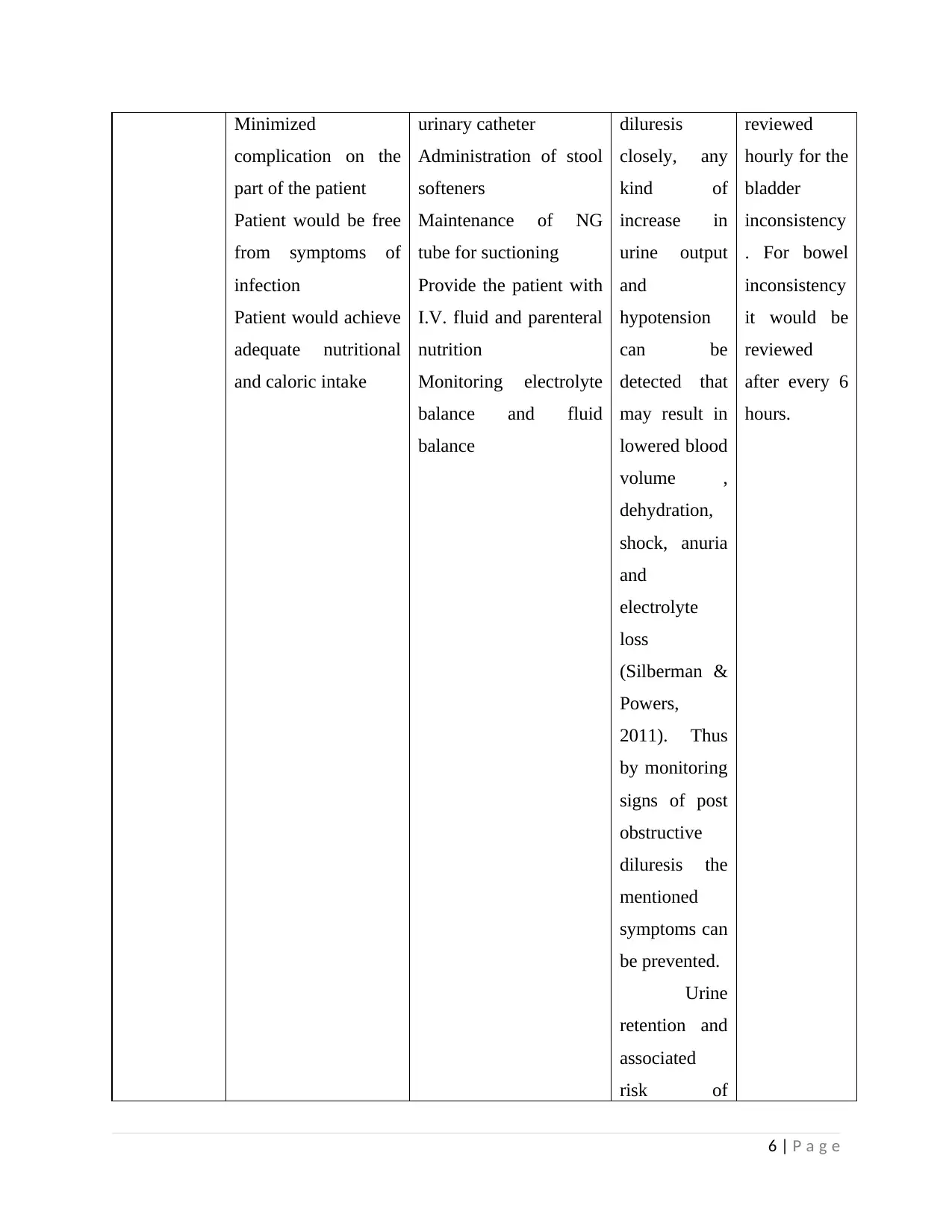
Minimized
complication on the
part of the patient
Patient would be free
from symptoms of
infection
Patient would achieve
adequate nutritional
and caloric intake
urinary catheter
Administration of stool
softeners
Maintenance of NG
tube for suctioning
Provide the patient with
I.V. fluid and parenteral
nutrition
Monitoring electrolyte
balance and fluid
balance
diluresis
closely, any
kind of
increase in
urine output
and
hypotension
can be
detected that
may result in
lowered blood
volume ,
dehydration,
shock, anuria
and
electrolyte
loss
(Silberman &
Powers,
2011). Thus
by monitoring
signs of post
obstructive
diluresis the
mentioned
symptoms can
be prevented.
Urine
retention and
associated
risk of
reviewed
hourly for the
bladder
inconsistency
. For bowel
inconsistency
it would be
reviewed
after every 6
hours.
6 | P a g e
complication on the
part of the patient
Patient would be free
from symptoms of
infection
Patient would achieve
adequate nutritional
and caloric intake
urinary catheter
Administration of stool
softeners
Maintenance of NG
tube for suctioning
Provide the patient with
I.V. fluid and parenteral
nutrition
Monitoring electrolyte
balance and fluid
balance
diluresis
closely, any
kind of
increase in
urine output
and
hypotension
can be
detected that
may result in
lowered blood
volume ,
dehydration,
shock, anuria
and
electrolyte
loss
(Silberman &
Powers,
2011). Thus
by monitoring
signs of post
obstructive
diluresis the
mentioned
symptoms can
be prevented.
Urine
retention and
associated
risk of
reviewed
hourly for the
bladder
inconsistency
. For bowel
inconsistency
it would be
reviewed
after every 6
hours.
6 | P a g e
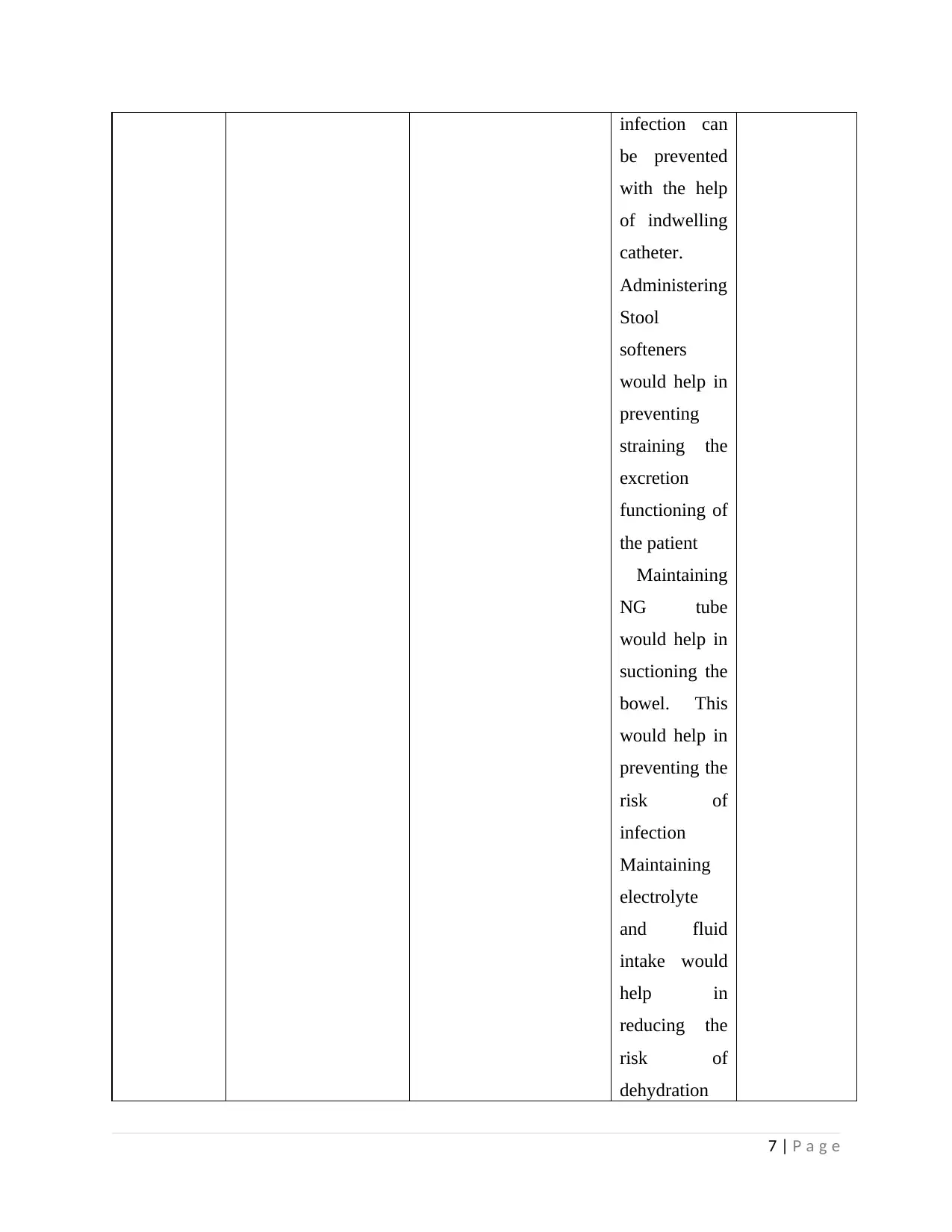
infection can
be prevented
with the help
of indwelling
catheter.
Administering
Stool
softeners
would help in
preventing
straining the
excretion
functioning of
the patient
Maintaining
NG tube
would help in
suctioning the
bowel. This
would help in
preventing the
risk of
infection
Maintaining
electrolyte
and fluid
intake would
help in
reducing the
risk of
dehydration
7 | P a g e
be prevented
with the help
of indwelling
catheter.
Administering
Stool
softeners
would help in
preventing
straining the
excretion
functioning of
the patient
Maintaining
NG tube
would help in
suctioning the
bowel. This
would help in
preventing the
risk of
infection
Maintaining
electrolyte
and fluid
intake would
help in
reducing the
risk of
dehydration
7 | P a g e
Paraphrase This Document
Need a fresh take? Get an instant paraphrase of this document with our AI Paraphraser
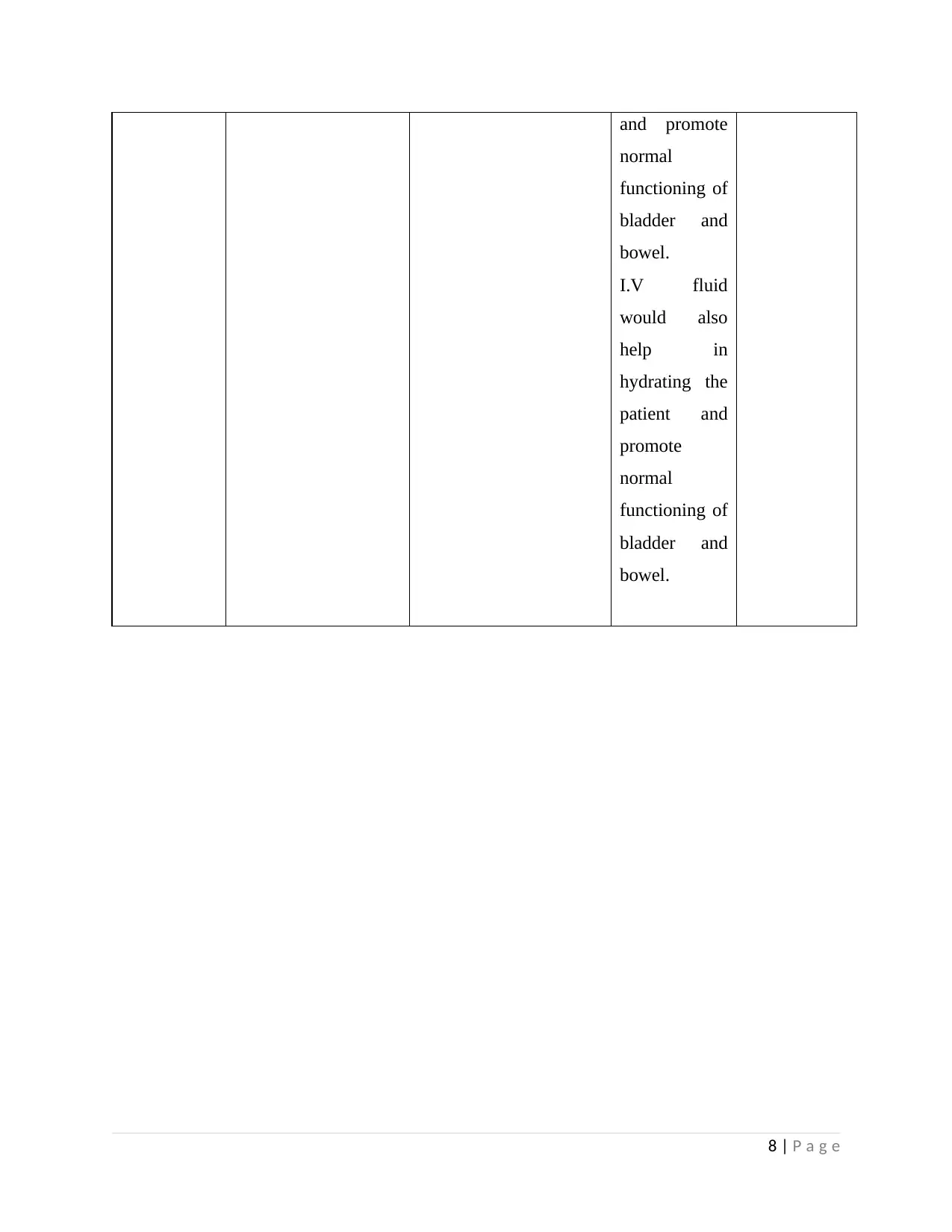
and promote
normal
functioning of
bladder and
bowel.
I.V fluid
would also
help in
hydrating the
patient and
promote
normal
functioning of
bladder and
bowel.
8 | P a g e
normal
functioning of
bladder and
bowel.
I.V fluid
would also
help in
hydrating the
patient and
promote
normal
functioning of
bladder and
bowel.
8 | P a g e
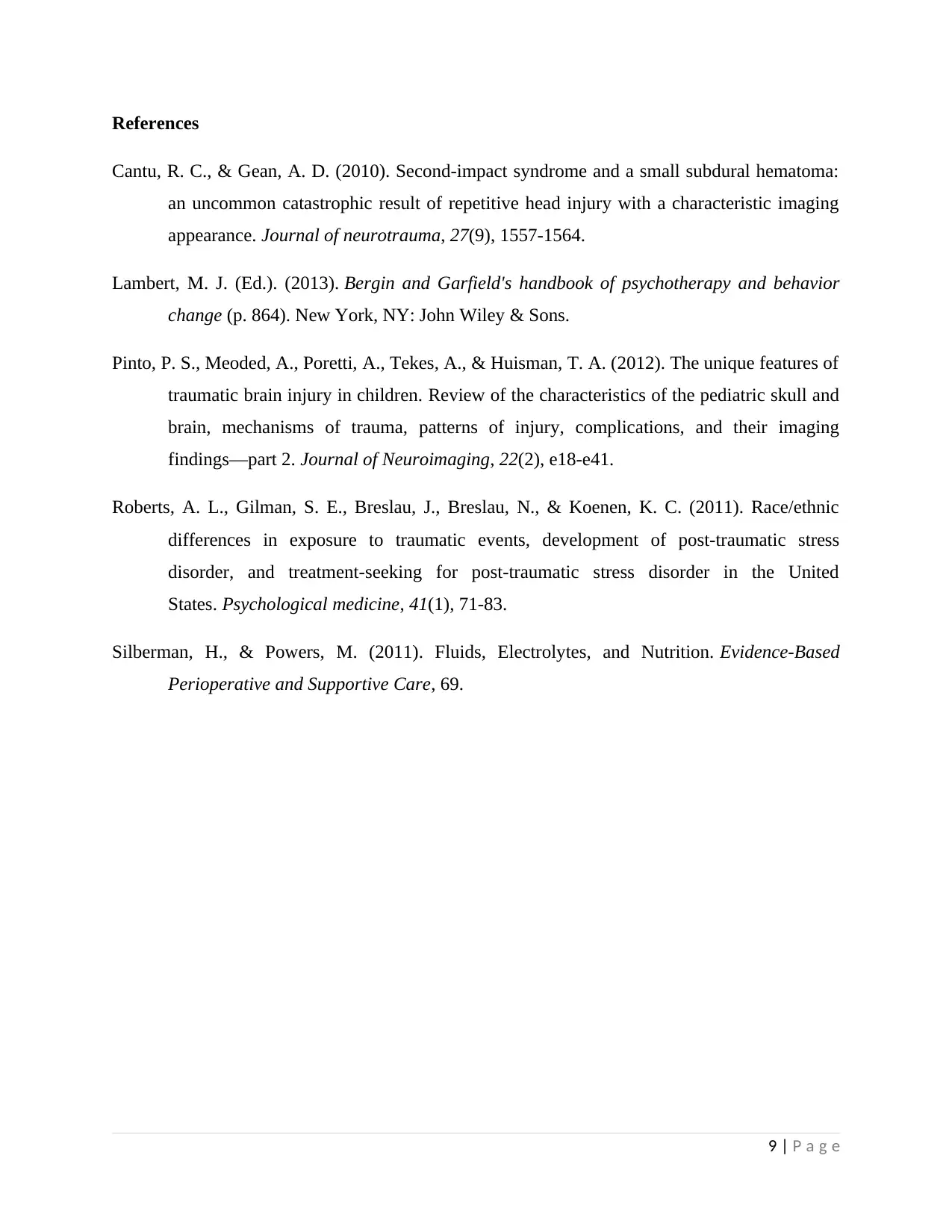
References
Cantu, R. C., & Gean, A. D. (2010). Second-impact syndrome and a small subdural hematoma:
an uncommon catastrophic result of repetitive head injury with a characteristic imaging
appearance. Journal of neurotrauma, 27(9), 1557-1564.
Lambert, M. J. (Ed.). (2013). Bergin and Garfield's handbook of psychotherapy and behavior
change (p. 864). New York, NY: John Wiley & Sons.
Pinto, P. S., Meoded, A., Poretti, A., Tekes, A., & Huisman, T. A. (2012). The unique features of
traumatic brain injury in children. Review of the characteristics of the pediatric skull and
brain, mechanisms of trauma, patterns of injury, complications, and their imaging
findings—part 2. Journal of Neuroimaging, 22(2), e18-e41.
Roberts, A. L., Gilman, S. E., Breslau, J., Breslau, N., & Koenen, K. C. (2011). Race/ethnic
differences in exposure to traumatic events, development of post-traumatic stress
disorder, and treatment-seeking for post-traumatic stress disorder in the United
States. Psychological medicine, 41(1), 71-83.
Silberman, H., & Powers, M. (2011). Fluids, Electrolytes, and Nutrition. Evidence-Based
Perioperative and Supportive Care, 69.
9 | P a g e
Cantu, R. C., & Gean, A. D. (2010). Second-impact syndrome and a small subdural hematoma:
an uncommon catastrophic result of repetitive head injury with a characteristic imaging
appearance. Journal of neurotrauma, 27(9), 1557-1564.
Lambert, M. J. (Ed.). (2013). Bergin and Garfield's handbook of psychotherapy and behavior
change (p. 864). New York, NY: John Wiley & Sons.
Pinto, P. S., Meoded, A., Poretti, A., Tekes, A., & Huisman, T. A. (2012). The unique features of
traumatic brain injury in children. Review of the characteristics of the pediatric skull and
brain, mechanisms of trauma, patterns of injury, complications, and their imaging
findings—part 2. Journal of Neuroimaging, 22(2), e18-e41.
Roberts, A. L., Gilman, S. E., Breslau, J., Breslau, N., & Koenen, K. C. (2011). Race/ethnic
differences in exposure to traumatic events, development of post-traumatic stress
disorder, and treatment-seeking for post-traumatic stress disorder in the United
States. Psychological medicine, 41(1), 71-83.
Silberman, H., & Powers, M. (2011). Fluids, Electrolytes, and Nutrition. Evidence-Based
Perioperative and Supportive Care, 69.
9 | P a g e
1 out of 9
Your All-in-One AI-Powered Toolkit for Academic Success.
+13062052269
info@desklib.com
Available 24*7 on WhatsApp / Email
![[object Object]](/_next/static/media/star-bottom.7253800d.svg)
Unlock your academic potential
© 2024 | Zucol Services PVT LTD | All rights reserved.